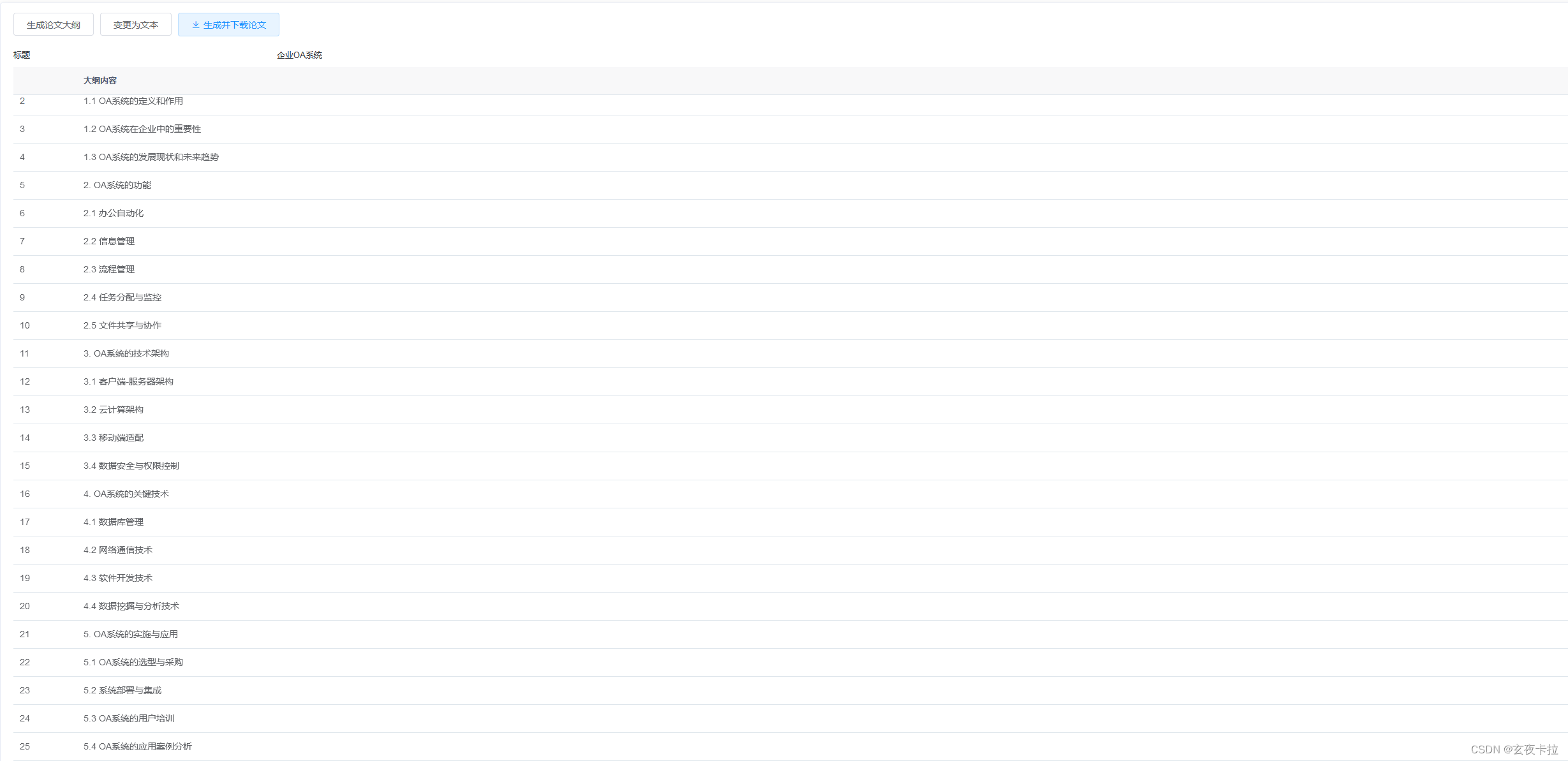大学开学了,博主的堂弟现在正值大四,论文是分毫未动,想要用国内网上的AI辅助写作拟一篇文章进行完成,刚好聊天了解此事,我有点感兴趣,去百度了一下,各个AI生成网站价格不菲,临时起意想做一个AI代码生成程序,当然这种生成的论文问题还是特别多,无法和成熟的软件相比不过胜在成本低,可塑性强。
前置条件
首先我们需要对接现有大模型的接口,国内的各个大模型都有自己的商场,GPT-4在理解和生成自然语言方面比国内的模型在具有更强的能力,因此作者嫌麻烦花了10米去搞了个国内的中转接口去调用GPT-4的api,否则你就需要魔法上网,去弄openAI的接口了。
代码实现
首先简单讲解一下AI对话的原理,首先要了解tokens,引用一句AI的解释:
在AI和机器学习的上下文中,"tokens" 通常是指文本数据被预处理后得到的基本单位。这些单位可以是单词、子词(subwords)、字符或更复杂的结构,取决于你选择的分词方法。Tokenization是自然语言处理中的一个重要步骤,它有助于将文本转换为机器学习模型可以理解和处理的形式。
简单来说就是你发送的消息和AI返回给你的内容都与tokens有关,字符越多,tokens越大,一般来说400个汉字,相当于1000tokens
而对话简单来讲就是你请求的时候会携带上文AI的回答或者你的塑造的上下文进行调用,如果不加限制就很容易消耗特别多的tokens,有些网站都是将次数限制到10条可能就是这个原因。
论文这个东西文本实在太多,使用我直接不考虑带上文,这里是我的创建对话的代码实现:
private ChatResponseWrapper createChat(String message, String model) {
try {
if (!chatConfig.isEnable()) {
log.warn("createChat fail,ai is unable!");
throw new AIExecuteException("check ai is enable!");
}
List<ChatMessagesDto> messages = new ArrayList<>();
ChatMessagesDto systemMessage = new ChatMessagesDto(role, message);
messages.add(systemMessage);
//model 代表gpt当前的模型,我开发时使用的是3.5,role代表当前的角色
ChatRequest chatCompletionRequest = ChatRequest.builder().model(model).messages(messages).user(role).maxTokens(4096).temperature(BigDecimal.ONE).build();
ObjectMapper objectMapper = new ObjectMapper();
//对接大模型的url
HttpRequest request = HttpUtil.createPost(chatConfig.getUrl());
request.setConnectionTimeout(TIMEOUT);
request.body(objectMapper.writeValueAsBytes(chatCompletionRequest));
// 设置请求头
request.header("Content-Type", "application/json");
//携带token
request.header("Authorization", "Bearer " + chatConfig.getAccessKey());
String body;
try (HttpResponse response = request.execute()) {
body = response.body();
}
if (log.isDebugEnabled()) {
log.debug("get Ai response body:{}", body);
}
ChatResponseWrapper wrapper = new ChatResponseWrapper();
wrapper.setResponse(objectMapper.readValue(body, ChatResponse.class));
wrapper.setQuestion(message);
return wrapper;
} catch (JsonProcessingException e) {
log.error("Json Parse error,message:{}", message, e);
throw new AIExecuteException(e.getMessage());
} catch (Exception e) {
log.error("createChat error,message:{}", message, e);
throw new AIExecuteException(e.getMessage());
}
}接下来创建生成大纲的接口,入参是标题,也就是前端传入的值
public List<ThesisOutline> genThesisOutline(String message) {
try {
String template = "以《{}》为题目,给我一篇计算类论文的大纲,使用中文回答,一级目录使用编号1,二级目录使用编号1.1,以此类推";
//对ai的问句
String askQuestion = StringUtil.format(template, message);
ChatResponseWrapper wrapper = aiClient.createChat35(askQuestion);
ChatResponse response = wrapper.getResponse();
if (response == null) {
throw new AIExecuteException();
}
List<ThesisOutline> thesisOutlines = new ArrayList<>();
for (ChatChoice choice : response.getChoices()) {
ChatMessagesDto choiceMessage = choice.getMessage();
String content = choiceMessage.getContent();
if (StringUtil.isEmpty(content)) {
continue;
}
//过滤为空的行和不为数字的行
List<String> outlines = StringUtil.split(content, "\n").stream().filter(StringUtil::isNotBlank).filter(StringUtil::isStartsWithDigit).map(String::trim).collect(Collectors.toList());
for (String outlineContent : outlines) {
ThesisOutline outline = new ThesisOutline();
outline.setContent(outlineContent);
thesisOutlines.add(outline);
}
}
return thesisOutlines;
} catch (Exception e) {
log.error("genThesisOutline error", e);
return Collections.emptyList();
}
}
/**
* 论文标题实体
* @author zwh
*/
@Data
public class ThesisOutline {
/**
* 层级
*/
private Integer level;
/**
* 标题内容
*/
private String content;
}
这个接口将生成的数据返回给前端

随手写的前端,样式什么的也懒的调了,能用就行,代码如下:
<template>
<div class="app-container home">
<el-card style="height: 95vh">
<el-button @click="genThesisOutline" :disabled="showText">生成论文大纲</el-button>
<el-button @click="toText" v-if="!showText">变更为文本</el-button>
<el-button @click="toList" v-if="showText">保存并展示为列表</el-button>
<el-button @click="downloadByOutline" icon="el-icon-download" v-if="!showText">生成并下载论文</el-button>
<div style="margin-top: 20px">
<div v-show="!showText">
<el-row style="margin-bottom: 10px">
<el-col :span="4">标题</el-col>
<el-col :span="20">{{ thesis.title }}</el-col>
</el-row>
<el-table ref="table" :data="outlineData" max-height="1100px">
<el-table-column type="index" width="100"/>
<el-table-column label="大纲内容" prop="content"/>
</el-table>
</div>
<el-form v-show="showText">
<el-form-item label="标题">
<el-input v-model="thesis.title"/>
</el-form-item>
<el-form-item label="大纲">
<el-input type="textarea" v-model="outlineText" rows="45"/>
</el-form-item>
</el-form>
</div>
</el-card>
<el-dialog title="生成论文大纲" :visible.sync="outline.visible">
<el-form>
<el-form-item label="论文题目">
<el-input v-model="outline.content"/>
</el-form-item>
</el-form>
<div slot="footer" class="dialog-footer">
<el-button @click="outline.visible = false">取 消</el-button>
<el-button type="primary" @click="genOutline">确认生成大纲</el-button>
</div>
</el-dialog>
</div>
</template>
<script>
import {downloadWord, genOutline} from "@/api";
export default {
name: "Index",
data() {
return {
outline: {
visible: false,
content: null,
},
outlineData: [],
thesis: {
title: null,
messages: []
},
outlineText: null,
showText: false,
};
},
methods: {
genThesisOutline() {
this.outline.visible = true;
},
genOutline() {
genOutline(this.outline.content).then(resp => {
this.outlineData = resp.data
this.thesis.title = this.outline.content
this.outline.content = null
this.outline.visible = false
})
},
toText() {
const fieldValues = this.outlineData.map(obj => obj.content);
this.outlineText = fieldValues.join('\n');
this.showText = true;
},
toList() {
// 使用 split 方法按换行符分割字符串
const lines = this.outlineText.split('\n');
// 过滤掉空字符串,并将每个字符串转化回对象
// 将每行转化为一个对象,该对象具有指定的字段名和内容
this.outlineData = lines
.filter(line => line.trim() !== '')
.map(line => ({content: line}));
this.showText = false;
},
downloadByOutline() {
this.thesis.messages = this.outlineData.map(obj => obj.content);
downloadWord(this.thesis).then(resp => {
// 创建一个blob对象URL
const url = window.URL.createObjectURL(new Blob([resp]));
// 创建一个下载链接元素
const link = document.createElement('a');
link.href = url;
link.setAttribute('download', this.thesis.title+'.docx'); // 设置下载文件名
// 触发下载
document.body.appendChild(link);
link.click();
// 清理
window.URL.revokeObjectURL(url);
})
}
},
};
</script>正文生成,因为是要对大纲的内容进行循环的请求,使用需要异步请求chatgpt,因为每一个论点请求花费的时间都十分之长,计算了一下一个论点大约30s左右,所以我们这里需要异步去请求论文返回的结果,我这里是使用CompletableFuture去异步请求,方法通过异步方式与AI交互,生成论文文本,并将结果导出为Word文档供用户下载。
@Override
public void genThesisText(List<String> messages, String title, HttpServletResponse resp) {
try {
String template = "请继续以{}为题生成关于:{}的内容,内容需要在500字以上";
List<CompletableFuture<ThesisTextModel>> futures = new ArrayList<>(messages.size());
// 每个标题异步创建会话
for (String message : messages) {
String question = StringUtil.format(template, title, message);
CompletableFuture<ThesisTextModel> future = CompletableFuture.supplyAsync(() -> ThesisTextModel.builder().wrapper(aiClient.createChat35(question)).message(message).build(), executor).exceptionally(e -> {
log.error("createChat sync execute error", e);
return null;
});
futures.add(future);
}
// 获取所有消息内容 (key: 问题, value: 回答)
Map<String, List<String>> allContent = new LinkedHashMap<>();
for (CompletableFuture<ThesisTextModel> future : futures) {
ThesisTextModel model = future.get();
ChatResponse response = model.getWrapper().getResponse();
List<ChatChoice> choices = response.getChoices();
String outline = model.getMessage();
ArrayList<String> perContent = new ArrayList<>();
for (ChatChoice choice : choices) {
ChatMessagesDto choiceMessage = choice.getMessage();
// 获取某个标题的回答内容
String content = choiceMessage.getContent().replaceAll("\n+", "\n");
if (StringUtil.isEmpty(content)) {
continue;
}
perContent.add(content);
}
allContent.put(outline, perContent);
}
// 生成 word 文档
ThesisBuildHelper.exportWordDocument(resp, allContent);
} catch (Exception e) {
log.error("genThesisText error", e);
}
}调用ThesisBuildHelper设置好相应的格式,这里贴上我大学时使用的论文格式(ps.还是从吃灰的老电脑里翻到的)

总结
经过两天的努力,到现在程序已经能够生成结构清晰、内容丰富的论文。同时,通过导出为Word文档的形式,使得我能够方便地查看和编辑生成的论文。
这样生成的论文成本也特别的低,我开发中使用的是gpt3.5,大概2w字的论文花费就2毛左右,可想而知百度到的论文生成网站里面利润之高,其实我还想了将gpt3.5生成的文章交给gpt4润色,加入参考文献,不过嫌麻烦,也没有好的思路,就懒得做了,说到底也是心血来潮。
最后,附以一张我毕业的论题生成的论文,27页字数23184,虽然不是标准的论文,但是再也不需要去冥思苦想论文该咋写了。





















 1472
1472











 被折叠的 条评论
为什么被折叠?
被折叠的 条评论
为什么被折叠?








